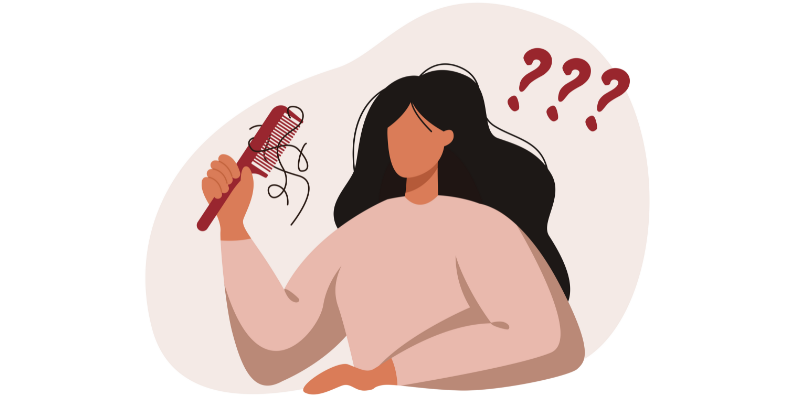By Sue Sveum
While many men embrace their baldness these days, women experiencing hair loss often grapple with a myriad of emotions. It hardly seems fair — but it’s not uncommon.
According to Harvard Medical School, as many as one-third of women deal with hair loss at some point. And, that jumps to two-thirds among postmenopausal women. The many causes of hair loss (alopecia) include:
- aging
- heredity
- hormones
- nutritional deficiencies
- medical and autoimmune conditions
- stress
Local experts Dr. Apple Bodemer, integrative dermatologist with UW Health, and Dr. Shamila Gupta Rawal, otolaryngologist/head and neck surgeon at The Rawal Institute for Hair Restoration and Aesthetic Medicine, break down what’s going on.
According to Dr. Bodemer, hair loss caused by stress (telogen effluvium), usually resolves on its own.
“Women see thinning and shedding everywhere,” she explains. “It often occurs after acute physical stress from infections (like Covid), heart attack, a car accident injury or major surgery. It’s also triggered by emotional stress from major life [events] — loss of a loved one or job, and even pregnancy.”
Dr. Bodemer says hair shedding or more hair loss than usual typically happens 4-6 months after the experience and usually stops once the stressor resolves or the body adapts to it. “But,” she says, “it can be a really stressful experience in the meantime.”
When stress doesn’t seem to be the cause if you’re experiencing hair thinning or loss, or you’re experiencing other health issues, it’s important to consult with your primary care physician or dermatologist to assess the underlying issue and treatment options. Your doctor may want to order labs to identify underlying medical issues that need to be addressed.
“Hereditary pattern baldness, marked by top and crown thinning, is very common,” says Dr. Rawal. “Common non-hereditary types [of hair loss] include alopecia areata, from the immune system attacking hair follicles; scarring alopecia, caused by inflammatory conditions; and traction alopecia, from tight hairstyles like ponytails, braiding and extensions.”
Both physicians agree that some over-the-counter products may be helpful. Topical minoxidil (Rogaine) in a 5% concentration can increase blood flow and nutrient delivery to hair follicles. Nutrafol also enhances hair growth. And Nioxin scalp serum may provide benefits. Products that are washed off the hair quickly, like shampoo or conditioner, are not likely to have an impact on hair growth, but can help strengthen the hair.
“There’s often some shedding two to four months into any minoxidil treatment,” cautions Dr. Bodemer. “That means it’s working — but users sometimes stop, thinking it’s making their hair fall out. [But the product] is actually shifting hairs into the growth phase, pushing out hair resting in the follicle.”
Medical treatments by professionals such Drs. Rawal and Bodemer may include topical and oral supplements and prescription medications, depending on the cause. Dr. Rawal also offers regenerative medicine, surgical hair transplants, low-level laser light therapy (LLLT) and scalp micropigmentation.
“Women define their individual style and personality by the way they wear their hair,” says Dr. Rawal. “It’s such an integral part of their identity, that it can be devastating when they start to lose hair. For most, hair restoration is often accompanied by restoration of self-esteem.”
Dr. Rawal’s patient, Marsha Goldstein, can relate.
“When I first noticed hair loss, I was devastated,” she says. “But after a series of treatments and ongoing medication my hair regained luster, fullness and curl.”
For women preferring not to seek treatment — or when medical treatment isn’t enough — Dr. Bodemer says working with a good hairstylist is a great way to camouflage hair loss. “Wigs and hairpieces have come a long way — have fun with them.”
HAIR HELPERS
MINOXIDIL
According to WebMD, “Minoxidil is the only over-the- counter medication for hair loss approved by the FDA for use by both men and women.” It’s the active ingredient in hair regrowth serums by various brands, including hers, Nioxin, Rogaine and private-label brands by Amazon and Walgreens, among others. Note that many of these OTC products have a 2% concen- tration of Minoxodil, and Dr. Bodemer and Dr. Rawal recommend a 5% concentration, so check labels before you purchase.
NUTRAFOL
This hair health brand has the “#1 dermatologist-recommended hair growth supplements for men and women,” according to their website. The brand also offers scalp care products to foster healthy hair growth. nutrafol.com
NIOXIN
Nioxin hair products and treatments are specially formulated for thinning hair. Find shampoos as well as products for hair growth, thickness and density boosting, scalp care and supplements. nioxin.com




